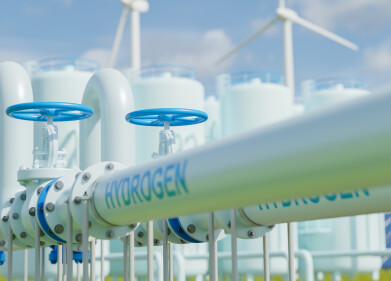Hydrogen fuel
Ammonia: what role could it play in decarbonisation?
Nov 28 2024
If it’s been given any thought, ammonia has featured in discussions about decarbonisation only as a storage form of hydrogen.
However, ammonia offers certain advantages over hydrogen that could revolutionise energy storage, transport, and use.
Useful in fuel cells and internal combustion engines, ammonia’s storability and transportability make it an interesting option for zero-carbon fuel – although improper use threatens air quality.
How does ammonia compare to hydrogen fuel?
Hydrogen, despite its clean-burning credentials, is notoriously difficult to store and transport, requiring cryogenic temperatures below -253°C or high-pressure tanks.
Ammonia, by contrast, can be stored as a liquid under far milder conditions, requiring only modest pressurization or refrigeration.
Since ammonia can directly replace hydrogen in its proposed applications, ammonia appears to be the more practical and cost-effective choice.
Do we lack infrastructure for ammonia?
The world already produces more than 200 million metric tons of ammonia annually, primarily for agricultural fertilizer.
This vast network of production plants, pipelines, and transport systems can be adapted for energy purposes, dramatically lowering the barriers to widespread adoption.
By adapting this existing infrastructure, ammonia directly avoids all of the carbon-intensive build-out that hydrogen will likely require.
Green credentials of ammonia fuel
Unlike fossil fuels, ammonia is carbon-free and emits no carbon dioxide when combusted – but it does have a lower gravimetric and volumetric energy density by comparison with fossil fuels.
Effective, complete combustion of ammonia produces only nitrogen gas and water vapour as byproducts, making it both cleaner and greener than many fossil fuels.
However, incomplete combustion spews out NOx, instead – therefore, if fuel cells are the powertrain technology of the future, strict regulation will be needed to prevent damage to air quality.
Ammonia as a form of green energy storage
Ammonia (NH3) is a compound of nitrogen and hydrogen, meaning it can be decomposed (‘cracked’) to produce hydrogen for fuel cells.
Because ammonia travels and stores easier than hydrogen, it can get the best out of hydrogen, which can be used effectively as a battery.
When there’s surplus renewable electricity, water can be electrolysed to produce hydrogen, synthesised into ammonia and shipped off.
Can we decarbonise the Haber-Bosch process?
Currently, the Haber-Bosch process produces most ammonia, getting its hydrogen from methane gas in a chemical reaction that releases CO2 as a by-product.
However, if pure hydrogen was renewably electrolysed and the process’ high temperatures provided by nuclear heating or electrical induction, Haber-Bosch could be made green.
Variants of this technology have been trialed with varying degrees of success in the UK, the USA, Norway, Australia and Oman.
Digital Edition
PIN 26.1 Feb/Mar 2025
March 2025
Analytical Instrumentation - Elemental Analysis for Quality and Process Control at Refineries, for Lubricants and Wear Metals in Engine Oils - Synthetic Lubricants: New Developments - Scaling...
View all digital editions
Events
Apr 08 2025 Birmingham, UK
Apr 08 2025 Kielce, Poland
Apr 08 2025 Ravenna, Italy
Apr 08 2025 Southampton, UK
Apr 08 2025 London, UK



















